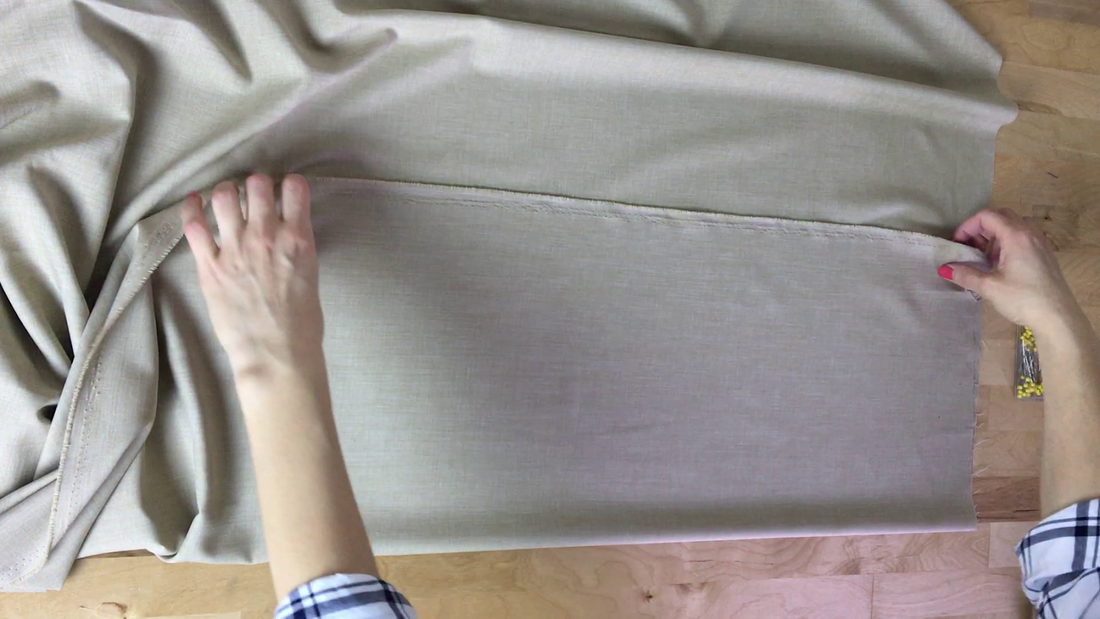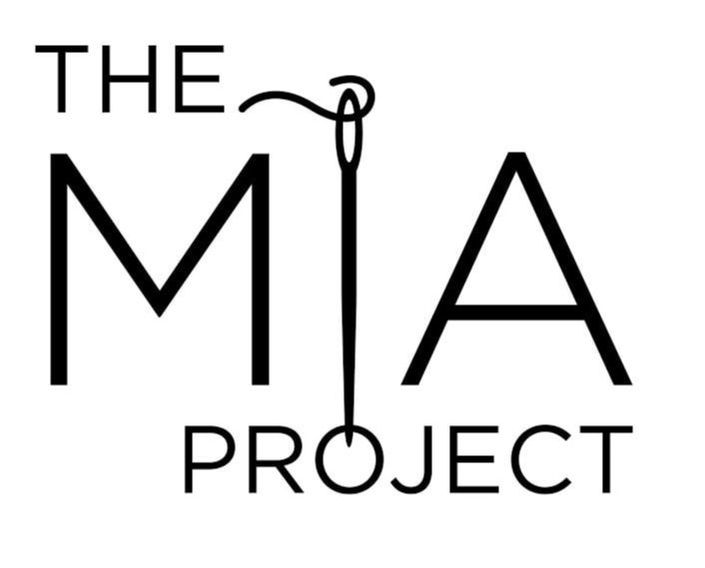|
On-seam pockets are a staple of functionality. Whether used on casual garments or formal styles, they are undeniably a valuable asset to the garment's versatility. I find myself adding pockets to any design I sew from scratch, any chance I get. They are fairly easy to pattern and sew, elevating the garment with the addition of just a few simple steps. On-seam pockets have now become somewhat essential to me. I don't know about you, but I'm always instinctively searching for pockets to house my keys or phone when I'm out and about (doing a million things at once). The simplicity of sewing on-seam pockets is often contingent on your sewing pattern. If you start off with a good, clear pocket pattern, the rest is easy to complete. There are a variety of different pocket bag shapes and styles you could choose from, but in this tutorial, I'll work from a skirt pattern to draft a simple, round pocket bag. When drafting pocket patterns, it is easiest to use the main pattern of the clothing item (you are adding the pocket to) as a blueprint. You will be using the actual seam (on the pattern) to generate the pocket pattern. My skirt will have a pocket on one side seam, thus I'll draw the actual pocket bag pattern directly on the main skirt pattern using the skirt's side seam as a guide. This technique works for any clothing item whether a skirt, dress or pants as long as you work directly on the seamline of the main pattern, at the exact desired location of the pocket. To get more clarity, follow the steps in the video tutorial above and/or the step-by step breakdown below. By the way, stay tuned to learn how to then sew this pocket in a video tutorial to come! Deciding The Pocket Location And Marking Its OpeningFirst and foremost, let's decide on the pocket's location. Although you could technically place it just about anywhere along the seam, keep in mind the pocket's optimal functionality. You want to be able to comfortably insert your hand and easily retrieve (or place) items in without any discomfort.
The best way to measure how far down to place an on-seam pocket is to measure its opening in relation to the waistline location on the pattern. This rule applies specifically to pockets sewn into the side seam, which technically is the most common application. As a general rule, the side seam pocket should open starting at about 3-5" down from the waistline. For optimal comfort, the pocket opening itself should be about 5-5 1/2" inches long, although that varies depending on your specifications (and type of pocket).
0 Comments
Every time I do a tutorial about invisible zippers, I spend the first paragraph talking about their convenience and how much I love using them. This time around, I'll (try to) spare you the long praise- well, aside from telling you that invisible zippers are probably one of the best inventions in dressmaking. In a previous sewing tutorial, I introduced you to the basics of sewing an invisible zipper using a regular zipper presser foot on your sewing machine (not invisible zipper foot). In this video tutorial, I'll walk you through an actual application of an invisible zipper into the side seam of a lined blouse. This application is widely used with form fitted woven dresses, especially those that are more formal and tailored. While my invisible zipper will be sewn into the side seam, you can use the same technique to apply it to any regular seam. It is called invisible for reason- When closed, invisible zippers blend into the seam, becoming essentially unnoticeable on the outside of the garment. This characteristic makes it ideal for a quick, clean garment closure that doesn't alter its design.
Its simplicity doesn't require any special seam manipulation aside from the necessity of a seam allowance that matches the invisible zipper tape. In most cases, the seam that will house the invisible zipper should have anywhere from 1/2" to 5/8" seam allowance, depending on the width of the zipper tape being used. The reason seam allowance is important with this type of zipper application is that for best (easiest) results, the zipper tape edges should be aligned with each corresponding seam allowance edges such that when closed, the zipper blends evenly into the seam without altering its fit or size. If you are a sewing beginner, the notion of sewing lining can be just as much confusing as rewarding when trying to fit all those fabric pieces together like a puzzle. The confusion often stems from the fact that there are various techniques you can use to fully line a garment, and honestly, all of them are usually correct. Sewing is not as black and white as you may think, and there are often a variety of different methods for achieving the same task. So before we get started, remove the notion that you have to sew lining using a single technique. Obviously, you want to choose the one that is easiest and most logical for the project at hand, but it's OK if you reverse the steps or switch up the rules a bit. In this tutorial, I'll show you the easiest technique for fully lining a sleeveless fitted blouse (with darts). This technique works only if you have a front or back seam that completely separates. Normally, a non-stretch woven garment that is lined will require some form of closure like a zipper, buttons, snaps etc. Zipper closures, of course, are simple and the most widely used so you can expect to have one down the center back seam in most form fitted, lined garments.
The blouse I'm lining in this tutorial is a crop top part of this sewalong in the making. This little crop top completes a two-piece cocktail dress that features a more tailored style. Naturally, a tailored garment is best finished with lining as it provides structure and emphasizes its clean lines. Video Tutorial: How To Draft A Sewing Pattern For A Non-Stretch Skirt Waistband (Faced Style).1/14/2019 Time for another patterning tutorial! I know drafting patterns is not exactly the most exciting topic, but if you really want to learn to how to design and make your own clothing, it is an essential tool in dressmaking. Learning some basic pattern drafting concepts is not only beneficial for those that want to construct the entire style from scratch, but also in the process of adjusting and altering store-bought, commercial patterns. As you become a more experienced sewist, you'll find yourself needing to do the latter a lot more than you may think. In this tutorial I'll walk you through an easy technique for drafting a non-stretch skirt waistband pattern. The same technique is applicable to other bottoms like trousers, shorts, and various other skirt styles. In this case, I'm working with a basic skirt pattern which has two darts at the front and two at the back. Due to the fact that both right and left sides of this basic skirt are symmetrical, the pattern in this tutorial is a cut on fold style. This means that I'll be working with only one side of the front skirt pattern (left) with the center front line serving as the cut on fold edge (the same applies to the back pattern piece). The center front and center back lines are the straight vertical lines that go down the very center of the front and respectively the back of a sewing pattern, dividing each (front and back) into two symmetrical sides. If you are working with a full pattern, you can still follow the steps described below to draft the waistband. Regardless of whether it is a cut on fold pattern or a full pattern, the center front and center back lines are an essential element to use in the process as it provides a guide to help you draft a perfectly symmetrical waistband (as you'll see below).
Ever since I started sewing years and year ago, the notion of cutting a pattern on fold has consistently presented itself. Cutting sewing patterns on fold is a technique very commonly used by beginner sewists and advanced dressmakers alike. Discussed in a previous introductory tutorial, utilizing the cut on fold technique, both in pattern drafting and cutting, can save space, pattern paper and make the cutting and patterning process more efficient and easy to handle. While this previous tutorial was more of a general introduction of these basic concepts, today's post will focus on two other equally important factors: How to correctly fold the fabric in preparation for pattern cutting, and how to transfer darts and other markings evenly to a cut on fold fabric piece. The latter can prove to be a bit more difficult to grasp as a beginner. Folding The Fabric In Preparation For Cutting A Pattern On FoldThe process of cutting a sewing pattern on fold starts with folding the fabric correctly. This entails paying attention to grain line and using the fabric's selvage edge to fold the fabric correctly on grain. If you need a refresher on fabric grain and how to position sewing patterns against the fabric, check out this tutorial: 4 Ways To Lay Out A Sewing Pattern For Cutting: Understanding Fabric Grain And The Selvage Edge. To start with, find the selvage edge closest to you and fold it over the fabric such that the wrong side of the fabric (if there is one) is facing out and the right side is sandwiched in between. The reason for this very specific placement is so that the markings which will later need to be transferred from pattern onto fabric end up on the wrong side of the fabric. This not only preserves the fabric's face side but having the markings on the wrong side correspond more comfortably to the way the fabric pieces are handled in the sewing process. In this instance, my fabric has no right or wrong side so I just folded it over evenly. Now for the big question, how much to fold the fabric? The way I estimate how much to fold the fabric is by positioning the sewing pattern next to the selvage edge and try to capture an approximate fold line. I always try to stay as close to the selvage edges as possible with just a bit of extra room (1/2-1"). Doing so will preserve fabric as well as help you work a lot more efficiently.
|
The Blog:A journey into our design process, sewing tutorials, fashion tips, and all the inspiring people and things we love. Doina AlexeiDesigner by trade and dressmaker at heart. I spend most of my days obsessing over new fabrics and daydreaming new ideas. Sadie
Executive Assistant & Client Relations Manager Archives
November 2019
Categories
All
|
-
Sewing Tutorials
-
Basics
>
- Aligning Pattern Grainlines To Fabric
- Preparing Fabrics For Sewing
- Pinning Sewing Patterns To Fabric
- Placing Sewing Patterns On Fabric For Cutting
- Rotary Cutters or Fabric Scissors?
- Cutting The Sewing Patterns
- What Are Notches And How To Use Them In The Sewing Process
- Transferring Notches From Pattern To Fabric
- Transferring Seamlines to Fabric
- Staystitching
- Backstitching: A Complete Guide
- Hand Basting: A Complete Guide
- Sewing Continuous Bias Binding
- Darts >
-
Sewing Seams
>
- The Basics Of Seams And Seam Allowance
- How To Sew A Straight Seam
- Sewing Curved Seams
- Sewing Corner Seams
- Trimming And Grading Seam Excess
- Notching/Clipping Seam Allowance for Tension Release
- Sewing Topstitched Seams
- Sewing Corded Seams
- Sewing A Slot Seam
- Sewing A Gathered Seam
- Sewing Bias Seams
- Sewing Seams With Ease
- Sewing Seams With Crossing Seamlines
- Sewing Unlike Fabric Seams
- How To Iron Seams: Ironing Tools And Conventions
- Sewing With Knit Fabrics
- Understanding Stitch Length And Tension
- Sewing Unique Fabric Seams
-
Seam Finishes
>
- Seam Finishing Techniques - Overview
- Applying A Pinked Seam Finish
- Applying A Bias Bound Seam Finish
- Serging And Zigzag Seam Finishes
- Sewing A Self-Bound Seam Finish
- Sewing A French Seam Finish
- Sewing A Hong Kong Seam Finish
- Sewing A Mock French Seam Finish
- Sewing A Turned-and-Stitched Seam Finish
- Sewing Overcast Hand-Applied Seam Finishes
- Sewing A Flat Felled Seam
- Sewing A Hairline Seam Finish
-
Hem Finishes
>
- Garment Hem Finishes: Overview
- Sewing A Double Fold Hem Finish
- Sewing A Single Fold Hem Finish
- Sewing Bound Hem Finishes
- Sewing An Exposed Double Layer Bound Hem
- Sewing A Folded-Up Bound Hem with Pre-folded Binding
- Sewing A Hong Kong Hem Finish
- Sewing A Band Hem Finish
- Sewing A Bias Faced Hem Finish
- Sewing A Twill Tape Hem Finish
- Sewing A Rolled Hem Finish
- Sewing A Shaped Hem Facing
- Using Fusible Hem Tape And Webbing
- Finishing A Lace Fabric Hem
- Finishing A Leather Hem
- Sewing Faced Hem Corners
- How To Finish Lining At The Hem
- Finishing Fabric Corners by Mitering >
- Interfacing A Hemline: Lined And Unlined Examples
-
Sewing Pockets
>
- Curved Patch Pocket With Flap
- Unlined Square Patch Pockets
- Lined Patch Pockets: Two Ways
- Extension On-Seam Pockets
- Separate On-Seam Pocket
- Front Hip Pockets
- Bound Double Welt Pocket
- Double Welt Pocket With Flap
- Self-Welt Pocket (Using Single Fabric Layer)
- Slanted Welt Pocket (Hand-Stitched)
- Faced Slash Pockets: Overview >
-
Sewing Zippers
>
- Sewing Zippers: General Information
- Sewing A Centered Zipper
- Sewing A Lapped Zipper
- Sewing An Invisible Zipper
- Sewing A Fly Front Zipper
- Sewing A Closed-End Exposed Zipper (No Seam)
- Sewing An Exposed Separating Zipper
- Sewing Hand Stitched Zipper Applications
- Sewing A Zipper Underlay
- Sewing A Placket-Enclosed Separating Zipper
- Sleeveless Finishes >
-
Neckline Finishes
>
- Sewing A Neck Shaped Facing
- Sewing An All-In-One Neck Facing
- Neck And Garment Opening Combination Facings >
- Sewing A Bias Faced Neckline Finish
- Sewing A Band Neckline Finish
- Bound Neckline Finishes: Overview >
- Sewing A Semi-Stretch Strip Band Neckline
- Ribbed Neck Band And Classic Turtleneck
- Decorative Neckline Finishes >
- Finishing Facing Edges >
-
Extras
>
- A Complete Guide on Interfacing
- Sewing Bound Spaghetti Straps
- Sewing Spaghetti Straps To A Faced Neckline
- Sewing Ruffles: Overview
- Patterning And Sewing A Circle Ruffle
- Sewing A Gathered Heading Ruffle
- Sewing Double Layer Gathered Ruffles
- Sewing A Gathered Ruffle Into A Seam
- Sewing A Gathered Ruffle To A Fabric Edge
- Sewing A Fabric Surface Slit
- Sewing A Slit Seam
- Hand-Applied Straight Stitches
- Hand-Applied Blind Stitches
- Hand-Applied Overedge Stitches
- Hand-Applied Tack Stitches
- Hand-Applied Decorative Stitches
-
Basics
>
- Custom Bridal
- Custom Apparel
- About
- Blog
Services |
Company |
|




 RSS Feed
RSS Feed

